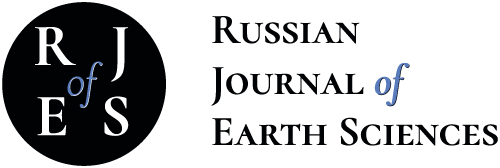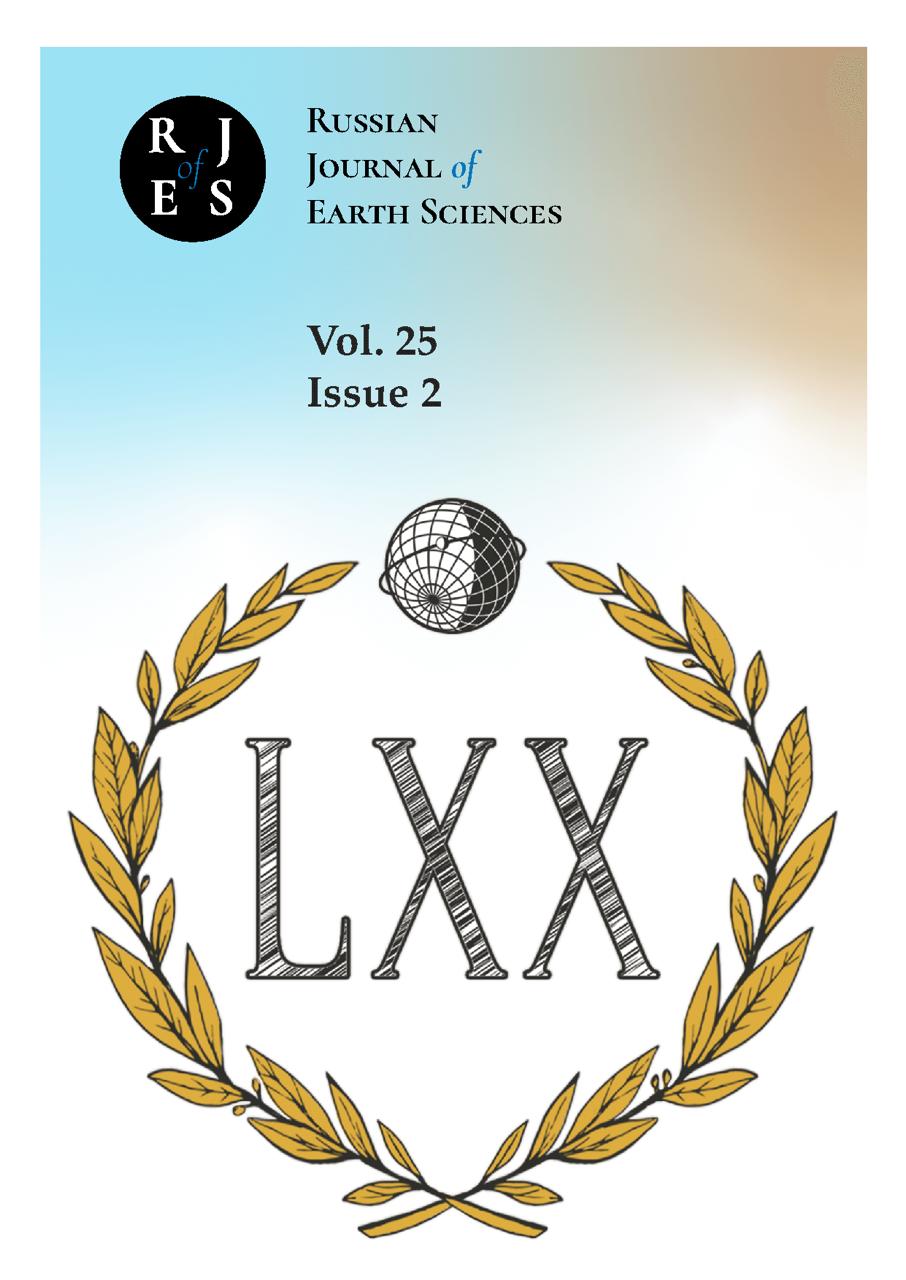Institute of Tectonics & Geophysics FEB RAS
Khabarovsk, Russian Federation
Russian Federation
Russian Federation
UDC 55
UDC 550.34
UDC 550.383
CSCSTI 37.01
CSCSTI 37.15
CSCSTI 37.25
CSCSTI 37.31
CSCSTI 38.01
CSCSTI 36.00
CSCSTI 37.00
CSCSTI 38.00
CSCSTI 39.00
CSCSTI 52.00
Russian Classification of Professions by Education 05.00.00
Russian Library and Bibliographic Classification 26
Russian Trade and Bibliographic Classification 63
BISAC SCI SCIENCE
Based on the analysis of the anomaly magnetic field for the Amur Plate and adjacent territories, a Curie Point Depth (CPD) map has been constructed, which we identify with the isotherm 578°C — the temperature of the Curie point of magnetite. Within the Amur plate, the CPD values range from 13.4 to 38.0 km. Three large areas are clearly visible on the map: 1) NE-trending zone with CPD values of 25–20 km — Yellow Sea-Korean Peninsula-Sea of Japan; 2) ENE-trending central zone with CPD values of 30–38 km. Large depth values are due to the presence of the late Paleozoic and Mesozoic sedimentary basins of Erlyan, Songliao and Sredneamursky; 3) ENE-trending central zone with CPD values of 30-38 km. Large depth values are due to the presence of the late Paleozoic and Mesozoic sedimentary basins of Erlyan, Songliao and Sredneamursky. The fourth area of decrease in CPD values spatially coincides with volcanic structures of Pliocene-Pleistocene age in the area of the Toko Stanovik. Comparison of the generated CPD map with the Amur plate boundaries determined mainly from seismic data shows that the surface boundaries of the plate coincide mainly with the zones of the largest gradients of the 578°C isotherm distribution in depth.
Amur plate, anomaly magnetic field, spectral analysis, Curie point depth
1. ArcGIS Desktop: Release 10. — Redlands, CA : ESRI, 2011.
2. Argus D. F., Gordon R. G., DeMets C. Geologically current motion of 56 plates relative to the no-net-rotation reference frame // Geochemistry, Geophysics, Geosystems. — 2011. — Vol. 12, no. 11. — DOI:https://doi.org/10.1029/2011gc003751.
3. Ashurkov S. V., Sankov V. A., Miroshnichenko A. I., et al. GPS geodetic constraints on the kinematics of the Amurian Plate // Russian Geology and Geophysics. — 2011. — Vol. 52, no. 2. — P. 239–249. — DOI:https://doi.org/10.1016/j.rgg.2010.12.017.
4. Deep Structure and Metallogeny of East Asia / ed. by A. N. Didenko, Y. F. Malyshev, B. G. Saksin. — Vladivostok : Dalnauka, 2010. — 332 p. — (In Russian).
5. Didenko A. N., Li Y.-F., Peskov A. Y., et al. Closure of the Solonker basin: Paleomagnetism of the Linxi and Xingfuzhilu formations (Inner Mongolia, China) // Russian Journal of Pacific Geology. — 2016. — Vol. 10, no. 5. — P. 317–336. — DOI:https://doi.org/10.1134/s181971401605002x.
6. Didenko A. N., Nosyrev M. Y., Shevchenko B. F., et al. Thermal structure of Sikhote Alin and adjacent areas based on spectral analysis of the anomalous magnetic field // Doklady Earth Sciences. — 2017. — Vol. 477, no. 1. — P. 1368–1372. — DOI:https://doi.org/10.1134/s1028334x17110198.
7. Gao G., Kang G., Li G., et al. Crustal magnetic anomaly and Curie surface beneath Tarim Basin, China, and its adjacent area // Canadian Journal of Earth Sciences. — 2015. — Vol. 52, no. 6. — P. 357–367. — DOI:https://doi.org/10.1139/cjes-2014-0204.
8. Imaev V. S., Imaeva L. P., Kozmin B. M. Buffer seismogenic structures between the Eurasian and Amur lithospheric plates in southern Siberia // Tikhookeanskaya Geologiya. — 2003. — Vol. 22. — P. 55–61. — (In Russian).
9. Li C.-F., Lu Y., Wang J. A global reference model of Curie-point depths based on EMAG2 // Scientific Reports. — 2017. — Vol. 7, no. 1. — DOI:https://doi.org/10.1038/srep45129.
10. Li S. H., Li C., Wang C. X. Boundaries of the Amurian Plate identified using multiple geophysical methods // Geosciences Journal. — 2019. — Vol. 24, no. 1. — P. 49–59. — DOI:https://doi.org/10.1007/s12303-019-0011-1.
11. Maus S., Barckhausen U., Berkenbosch H., et al. EMAG2: A 2–arc min resolution Earth Magnetic Anomaly Grid compiled from satellite, airborne, and marine magnetic measurements // Geochemistry, Geophysics, Geosystems. — 2009. — Vol. 10, no. 8. — DOI:https://doi.org/10.1029/2009gc002471.
12. Meyer B., Saltus R., Chulliat A. EMAG2v3: Earth Magnetic Anomaly Grid (2-arc-minute resolution) / NOAA National Centers for Environmental Information. — 2017. — DOI:https://doi.org/10.7289/V5H70CVX.
13. Petit C., Fournier M. Present-day velocity and stress fields of the Amurian Plate from thin-shell finite-element modelling: Modelling Amurian Plate tectonics // Geophysical Journal International. — 2004. — Vol. 160, no. 1. — P. 358–370. — DOI:https://doi.org/10.1111/j.1365-246x.2004.02486.x.
14. Sakhno V. G. Most recent and present-day volcanism of the southern Far East. — Vladivostok : Dalnauka, 2008. — 128 p. — (In Russian).
15. Tanaka A., Okubo Y., Matsubayashi O. Curie point depth based on spectrum analysis of the magnetic anomaly data in East and Southeast Asia // Tectonophysics. — 1999. — Vol. 306, no. 3/4. — P. 461–470. — DOI:https://doi.org/10.1016/s0040-1951(99)00072-4.
16. Wang J., Li C.-F. Curie point depths in Northeast China and their geothermal implications for the Songliao Basin // Journal of Asian Earth Sciences. — 2018. — Vol. 163. — P. 177–193. — DOI:https://doi.org/10.1016/j.jseaes.2018.05.026.
17. Xiong S.-Q., Yang H., Ding Y.-Y., et al. Characteristics of Chinese continent Curie point isotherm // Chinese Journal of Geophysics. — 2016. — Vol. 59, no. 6. — P. 643–657. — DOI:https://doi.org/10.6038/cjg20161008.
18. Yarmolyuk V. V., Kozlovsky A. M., Travin A. V., et al. Duration and Geodynamic Nature of Giant Central Asian Batholiths: Geological and Geochronological Studies of the Khangai Batholith // Stratigraphy and Geological Correlation. — 2019. — Vol. 27, no. 1. — P. 73–94. — DOI:https://doi.org/10.1134/s0869593819010088.
19. Zonenshain L. P., Savostin L. A. Introduction to Geodynamics. — Moscow : Nedra, 1979. — 311 p. — (In Russian).

















